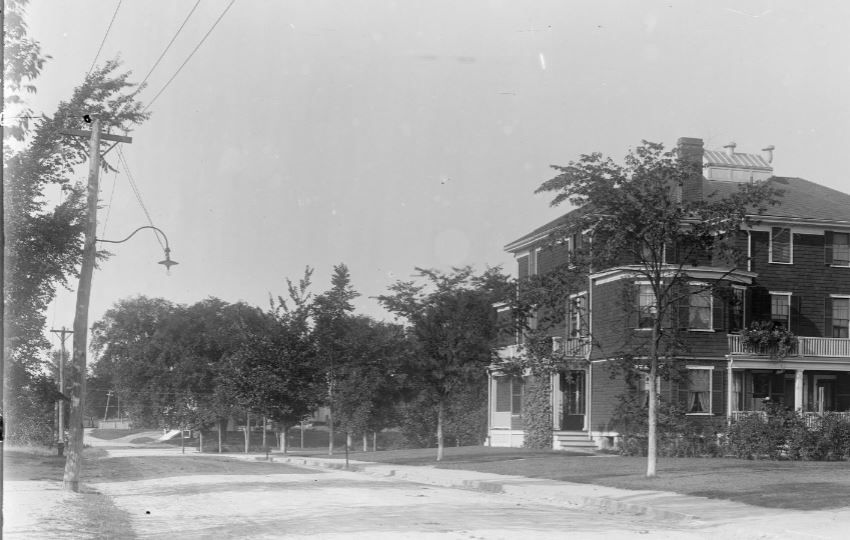Hingham Municipal Lighting Plant, MA, 1920-1921, Electric Service Pole, Overview
By Joe Maurath, Jr.; posted July 15, 2020
View Original: Click to zoom, then click to magnify (850 x 540) 78KB

|
Residential lighting service pole on a side street in Hingham, MA during 1920 with a street-series street light upon it. A "breaker" or "guy wire" type insulator was used in this instance to deadend the two street lighting conductors for the two wires that operated the lamp. Click "Next" for a close look of this old pole and its light fixture. Fixtures like this one represent some of the earliest days of incandescent street lighting. By the teens and early 1920s utility companies were replacing them with heavier, more durable ones. These had 1-1/4-inch steel pipe brackets with ornate wrought iron undersupports. The fixtures upon them were made of porcelain; typically green or black, and provided much better insulating qualities than their "gooseneck" pipe predecessors like you see here. The porcelain-bodied luminaires were introduced in the early 1910s. They accomodated "ruffled" (radial-wave) reflector shades for the smaller bulbs and some used glass globes for the bigger, brighter lightbulbs. During the early 1920s WW1 was coming to its end and the cost of coal and utility labor was somewhat stabilizing. During 1920, the forementioned utility's wholesale cost for electricity remained at 4 cents per kilowatt hour from its provider, the Weymouth Light and Power Company. In their contract they stated "this amount could rise to 4.5 cents maximum should coal become more of a shortage and if higher labor costs are incurred..." During that year it was expected that lower energy charges would eventually incur once WW1 ended. Other interesting facts, figures and events... The Town Light Plant stated there were 5,604 Hingham residents and 1,203 customers. This compares to 4,965 persons living in town with 565 customers in 1911. ....The transformer upgrade program was moving along swiftly, line losses (efficiency) was increased to 79.4 percent compared to 61.9 percent in 1911.... A short stretch of roadway in Hingham has its boundary with Cohasset right down the middle of it. The utility poles were on the Cohasset side and owned by a private utility. In their 1921 report, "the board has made satisfactory agreement with the Electric Light and Power Company of Abington and Rockland wherein the latter agrees to furnish current to the Electric Light Department to supply Hingham residents on Hull Street". Those on the Hingham side were billed from the Light Plant, having all the benefits of the rest of Hingham customers. There still is only one electric utility line along that roadway serving about 50 customers on the Hingham side and the private utility (National Grid) owns it. The customer service drops are also their property and with Hingham Light Plant meters. According to Massachusetts statute, the private utility is reimbursed by the town for the total Hingham-side usage each month. |